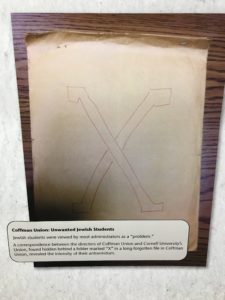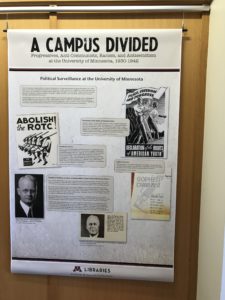Unfortunately, not even a century ago, they were.
Earlier this month, a former professor of mine, Riv-Ellen Prell, walked me through a new exhibit she co-curated at Andersen Hall on the U’s West Bank campus.
After spending some time researching and looking through historical documents, she and grad student Sarah Atwood found that the campus was directly involved in the political climate of the state in the 1930s and 40s.
Segregated Housing
The first thing Professor Prell pointed out to me was a document from Ruth Boynton (of Boynton Health), which tracked the numbers of African Americans (then called Negroes) and Jews. Of course, the U of M is a public institution, so it was accepting Jews and African Americans at the time, but they were clearly identified as being different than the other students.
“This institution had a racial hierarchy. It wasn’t a Southern college, it wasn’t a private school that discriminated. It was a public school that did admit [all] students, but Jews and African Americans were not like other students,” she said.
The University openly discriminated against these students by segregating housing and even denying African Americans housing on campus.
But the most surprising thing, I think for me, was learning that our very own President Coffman (think Coffman Memorial Union) spearheaded these efforts. Coffman enforced segregation in housing and insisted that it wasn’t a policy of the University. Yet, we have named our central student union after this man.
Jewish students had a bit of a leg up compared to the black students in terms of their overall experience, but definitely not up to par with the white students.
One document of a correspondence between the director of the Cornell University student union and Coffman Union in 1941 really summed up the public opinion about Jews at the time. The head of the Cornell union gave his sympathies about the Jewish “race problem.” And this was happening at the same time as Jews were being slain in Europe.

The file containing the correspondence between the directors of Coffman Union and Cornell University’s union, found in the union archives, marked “X.” This revealed the schools’ attitudes toward Jewish students on campus.
To be honest, yes, that is pretty astonishing to hear about, but it just makes me wonder: has this mindset even disappeared? Walking through this exhibit, I couldn’t help but think about the fact that we all think we live in an age where that type of thinking doesn’t exist and that we’re safe, but that’s not necessarily the case, as we see with today’s political climate.
Just a few weeks ago, white supremacists and neo-Nazis flocked from across the United States to rally in Charlottesville, and our president condemned violence on “all sides.” And we can’t forget the swastikas and bomb threats that targeted Jewish centers across the country, Minneapolis included.
I guess what I’m trying to say is, I don’t feel directly under attack like I’d imagine the students in the 1930s and 40s did, but I do feel that there is a sort of underlying presence of antisemitic and racist hate.
It was really hard for me to understand how the University got away with it, which I asked Professor Prell about. She responded with: “Not only did they get away with it, Jews loved Minnesota, because there were quotas at private schools but not here.”
And I guess if you’re hated everywhere, and state schools don’t have quotas, you probably would love the U — I don’t blame them for that.
Political Surveillance
Constantly being accused of being a communist campus, the University became obsessed with anticommunism and “exposing” communists in the 1930s and early 40s.
The second half of the exhibit showed documents related to this surveillance and basically spying, with pages upon pages documenting the University colluding with Ray P. Chase, who dedicated his entire career to Republican political operatives trying to expose communists.
At the forefront of this was Dean Edward Nicholson, who was constantly sending spies and keeping track of suspected radicals and sending them on to Chase. Many of the students were identified by their Jewishness, which apparently equates to being radicals, communists and thus, un-American. If you’re at all familiar with Nicholson Hall, it currently houses our Jewish Studies department here at the University, which was curious to me.
The antiwar movement was huge among students at the time, who believed the U.S. should not be involved in any war because of the impact WWI had on morale. But at the same time, the University under Dean Nicholson was doing everything in its power to censor and suppress student speech. Something we’re not at all familiar with on campus today… (That was a joke. Think protests at the Law School back in 2015).
In 1935, two speakers were invited to speak on campus, African American poet Langston Hughes and Nazi ambassador Hans Luther. But Chase asked Dean Nicholson to find out how much Hughes was being paid, while protesters were banned from Hans Luther’s appearance.
Clearly, there was a lot going on at this time that wouldn’t fly today. But going through the exhibit, the similarities and comparisons we can make to today are really incredible, even though nearly eight decades have passed.
It makes me wonder about all these past University presidents we have buildings named after around campus. Maybe the U should be re-thinking the names of these buildings after what these people did and said? Call me idealistic, but isn’t it the University’s responsibility to address the meaning behind these legacies?
‘A Campus Divided: Progressives, Anti-Communists, and Anti-Semitism at the University of Minnesota, 1930-1944’ runs through November 30 at the Elmer L. Andersen Library Atrium Gallery.
The American Studies, German, Scandinavian & Dutch and History Departments and the Jewish Community Relations Council of Minnesota and the Dakotas are hosting Riv-Ellen Prell at Temple Israel on Sept. 6 from 7:30-9 p.m. The event is free and open to the public.



2 comments